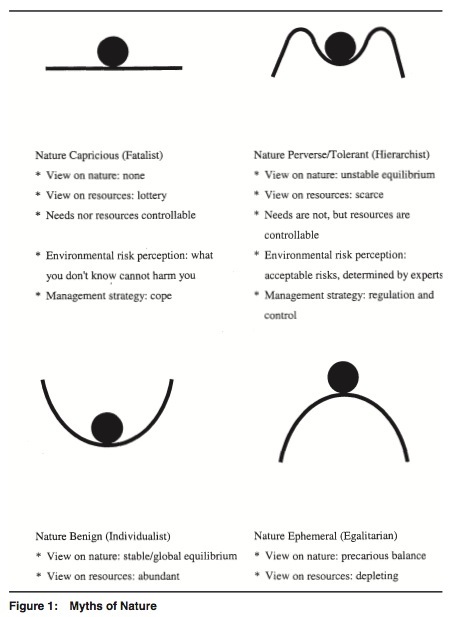The Myths of Nature
The excerpt further below is taken from “Steg, L. and I. Sievers (2000). “Cultural theory and individual perceptions of environmental risks.” Environment and Behavior 32(2): pp. 250-269.”
Thus far, I was quizzed by two people with regards to the importance of Green IT, Green IS, the use of technology for eco-sustainability, the broader issue of climate change and global warming. Apparently, some people are still skeptical about these issues.Well, as usual, I will share with them my point of view. My stand is this: Out there, there are skeptics (they are the minority by the way). And then, there are the dominant view of those who are the true believers of climate change and global warming. The scientific community, the data and the extreme weather occurrences all over the world provide the facts. And then there are of course people who hold the third view. The view of “precautionary principle”. They are generally believers themselves, but at the same time, they are a bit reserved. But they also hold the principle of “WHAT IF … ” the impact of climate change do happen, as demonstrated through simulations, through actual happenings, etc. And I share this view. This research is interested in .. WHAT IF .. and how technology can be used to influence towards positive impacts and avoid the consequences of the What If It Turns True.
The paper by Steg & Sievers (2000) explains the dispositions, perceptions or habituses of people towards the issue of environmental problems. Beyond the proponents, skeptics and third view, they offer another classification. Based on past studies and based on their own empirical research, discussion surrounding the myths of nature is discussed. And the four myths of nature include:- nature capricious (fatalists),
- nature perverse/tolerant (hierarchists),
- nature benign (individualists), and
- nature ephemeral (egalitarians).
Very nice way of bundling eh??? Wish I could do the same … This paper will certainly offers a lot to the discussion of my data. TQ to my SV for sharing this paper with me. As always, very thankful for having such an amazing SV!
+++
“One does not know all the risks one faces. The nature, the seriousness, and the consequences of most environmental problems—for example, the green-house effect and acid rain—are uncertain. Moreover, there is a lot of discussion in the scientific community regarding the seriousness of environmental problems, the need for managing these risks, and the (type of) measures that should be taken (Roe, 1996). No one knows what will happen if these environmental problems are neglected, and no one always knows how to solve or to prevent these problems. As a consequence, environmental policy as well as the perceived acceptability of this policy is to a large extent based on risk perceptions and risk judgments of various groups of experts and laypersons. Understanding differences in risk perception and risk judgments might facilitate the design of effective environmental risk management strategies.
Different groups in society may evaluate environmental risks differently. Attempts to explain environmental concerns in terms of standard demographic variables have generally not fared well (Jones & Dunlap, 1992). Cultural theory implies that risks are socially constructed; namely, people choose what to fear and how to fear it to sustain their preferred pattern of social relations (Douglas & Wildavsky, 1982). In essence, cultural theory accounts for the social construction of risk in terms of three interlinked domains: (a) the form of social relationships people maintain; (b) cultural biases such as shared values and beliefs including views on human nature, views on society, risk perceptions, and so-called myths of nature, which especially refer to biases toward environmental risks; and (c) preferred behavioral strategies (see Douglas & Wildavsky, 1982; Schwarz & Thompson, 1990; and Thompson, Ellis, & Wildavsky, 1990, for a comprehensive overview of cultural theory). The three domains constitute four systematic different ways of life: fatalists, hierarchists, individualists, and egalitarians.“
